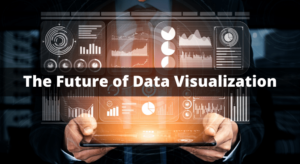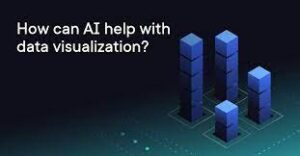
The Future of Data Visualization
The Future of Data Visualization: How AI is Revolutionizing the Field
In today’s data-driven world, Artificial Intelligence and Data Visualization converge, unveiling new dimensions of understanding and empowering organizations to transform information into actionable intelligence. Effective data visualization is more crucial than ever before. As businesses and organizations gather increasingly vast amounts of data, the ability to present and analyze that information in meaningful ways becomes a key competitive advantage. AI-powered data visualization tools are rapidly becoming the go-to solution for businesses looking to gain deeper insights and make better decisions.
But while traditional data visualization methods have served us well, there’s a new player on the scene that’s revolutionizing the field: artificial intelligence (AI). This article will explore how AI is transforming data visualization, the benefits it offers, and what the future of this dynamic field looks like. Whether you’re a data analyst, marketer, or business owner, understanding the role of AI in data visualization is essential for staying ahead of the curve. So, let’s dive in!
The Limitations of Traditional Data Visualization Methods:
Traditional data visualization methods rely heavily on human interpretation, which can lead to errors, inconsistencies, and biases. These methods are often time-consuming and require a high degree of technical expertise to implement effectively. Additionally, traditional data visualization methods face limitations in effectively processing and analyzing a significant amount of data.
The Role of Artificial Intelligence in Information Visualization:
AI-powered data visualization tools are rapidly becoming the go-to solution for businesses looking to gain deeper insights and make better decisions. AI algorithms can quickly and accurately analyze vast amounts of data, identify patterns and correlations, and present the results in visually compelling ways. Businesses can access insights that were previously hidden or difficult to uncover with the use of AI-powered data visualization tools.
One of the key advantages of AI-powered data visualization is the ability to automate the data analysis process. This allows businesses to save time and resources, while also ensuring more accurate and consistent results. AI-powered data visualization tools can also help identify outliers and anomalies in the data, which can be crucial for identifying potential problems or opportunities.
Benefits of Artificial Intelligence Powered Information Visualization:
The benefits of AI-powered data visualization are numerous. By using AI algorithms to analyze data and present it in meaningful ways, businesses can:
– Gain deeper insights into customer behavior and preferences
– Identify trends and patterns that may not be immediately apparent
– Make more informed decisions based on data-driven insights
– Save time and resources by automating the data analysis process
– Identify potential problems or opportunities before they become critical
AI-powered data visualization can also help businesses stay ahead of the competition by identifying trends and patterns that may not be immediately apparent. By using AI algorithms to analyze data, businesses can identify emerging trends and adjust their strategies accordingly.

Artificial Intelligence Powered Data Visualization Tools and Software:
There are a variety of AI-powered data visualization tools and software available on the market today. These tools range from simple charting and graphing software to complex machine learning algorithms that can analyze vast amounts of data. Some of the most popular AI-powered data visualization tools and software include:
– Tableau: a powerful data visualization software that allows businesses to create interactive dashboards and reports
– Power BI: a business analytics service provided by Microsoft that allows businesses to create interactive reports and visualizations
– Domo: a cloud-based business intelligence platform that allows businesses to create real-time dashboards and reports
– QlikView: a data visualization and business intelligence tool that allows businesses to create interactive dashboards and reports
Case Studies of AI-Powered Data Visualization in Different Industries
AI-powered data visualization has already proven to be a game-changer in a variety of industries. Here are a few examples:
Healthcare:
The healthcare industry is utilizing AI-powered data visualization tools to analyze patient data and identify potential health risks. By analyzing vast amounts of patient data, AI algorithms can identify patterns and correlations that may not be immediately apparent to human analysts. Additionally, this can help healthcare providers identify potential health risks before they become critical.
Retail:
In the retail industry, AI-powered data visualization tools are being used to analyze customer behavior and preferences. By analyzing customer data, retailers can identify trends and patterns that may not be immediately apparent, allowing them to adjust their product offerings and marketing strategies accordingly.
Finance:
In the finance industry, AI-powered data visualization tools are being used to identify potential market trends and investment opportunities. By analyzing vast amounts of financial data, AI algorithms can identify patterns and correlations that may not be immediately apparent to human analysts.
The Impact of Artificial Intelligence on the Field of Data Visualization:
The impact of AI on the field of data visualization is significant. Companies are already using AI-powered information visualization tools to automate the data analysis process, save time and resources, and identify emerging trends and patterns. As AI algorithms become more sophisticated and powerful, we can expect to see even greater advances in the field of data visualization.
Challenges and Ethical Considerations in AI Information Visualization
As with any new technology, there are challenges and ethical considerations associated with AI-powered information visualization. One of the primary challenges lies in actively ensuring the accuracy and reliability of the data being analyzed. It is imperative to actively verify that the data being analyzed is accurate and reliable, as the effectiveness of AI algorithms strongly relies on the quality of the data they receive.
AI-powered data visualization brings forth ethical considerations as well. For example, there is a risk that AI algorithms could be used to perpetuate biases or discrimination if the data being analyzed is biased or discriminatory. It’s important to ensure that AI-powered data visualization tools are used ethically and responsibly.
Future Possibilities and Advancements in AI-Powered Information Visualization
The future of AI-powered data visualization is exciting. As AI algorithms become more sophisticated and powerful, we can expect to see even greater advances in the field of data visualization. Here are a few possibilities:
– AI-powered data visualization tools that can identify emerging trends and opportunities in real-time
– AI algorithms that can analyze unstructured data, such as social media posts and customer reviews
– AI-powered data visualization tools that can identify potential problems or opportunities before they become critical
– AI-powered data visualization tools that can help businesses predict future trends and behaviors
Conclusion:
AI-powered data visualization is revolutionizing the field of data analysis and presentation. By using AI algorithms to analyze vast amounts of data and present it in visually compelling ways, businesses can gain deeper insights, make better decisions, and stay ahead of the competition. While there are challenges and ethical considerations associated with AI-powered data visualization, the future possibilities and advancements in the field are exciting. As businesses continue to gather increasingly vast amounts of data, the need for effective data visualization will only continue to grow.
